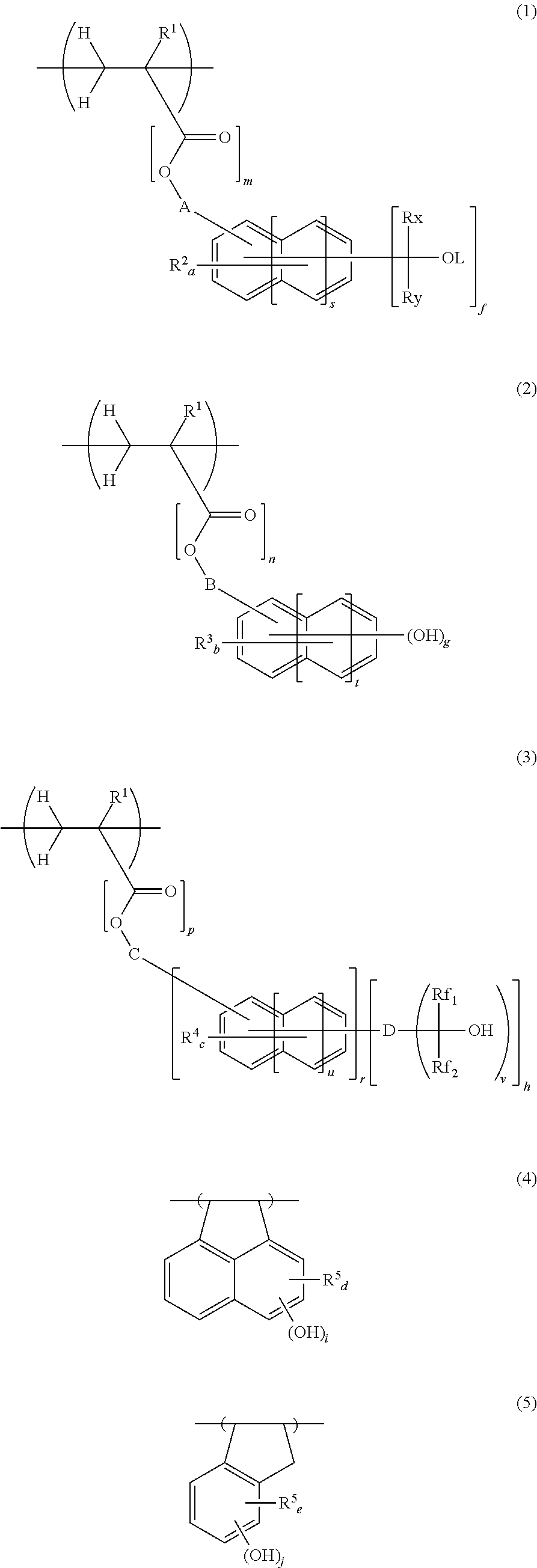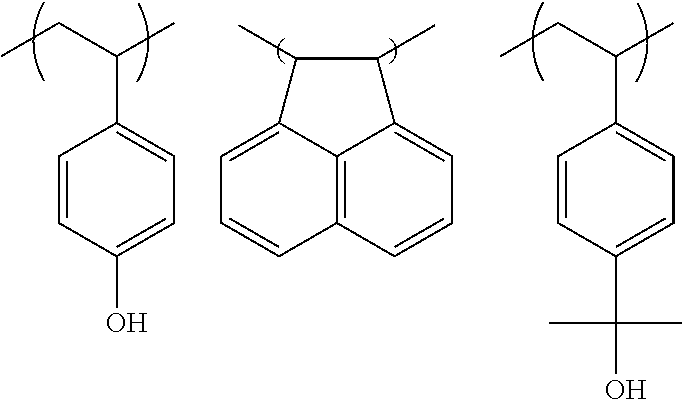Chemically amplified negative resist composition and pattern forming process
a technology of composition and pattern forming process, applied in the direction of photosensitive materials, instruments, photomechanical equipment, etc., can solve the problems of complex pattern design, difficult to complete the solution of the problem, and high cost, and achieve the effect of high resolution
- Summary
- Abstract
- Description
- Claims
- Application Information
AI Technical Summary
Benefits of technology
Problems solved by technology
Method used
Image
Examples
polymer synthesis example 1
[0112]In a 200-mL dropping funnel under nitrogen blanket, a solution was prepared by dissolving 39.26 g of 4-acetoxystyrene, 6.16 g of acenaphthylene, 19.6 g of 4-(2-hydroxy-2-propyl)styrene, and 7.43 g of dimethyl 2,2′-azobis(2-methylpropionate) (V601, Wako Pure Chemical Industries, Ltd.) in 90 g of methyl ethyl ketone (MEK) as a solvent. A 500-mL polymerization flask was purged with nitrogen, charged with 60 g of MEK, and heated at 80° C. In this state, the solution was added dropwise to the flask over 4 hours. After the completion of dropwise addition, stirring was continued for 18 hours while maintaining the polymerization temperature of 80° C. The polymerization solution was then cooled down to room temperature and added dropwise to 1,000 g of hexane whereupon a copolymer precipitated. The copolymer precipitate was collected by filtration and washed twice with 200 g of hexane. In a 1-L flask under nitrogen atmosphere, the copolymer was dissolved in a solvent mixture of 126 g of...
polymer synthesis example 2
[0113]In a 300-mL dropping funnel under nitrogen blanket, a solution was prepared by dissolving 39.5 g of 4-hydroquinone monomethacrylate, 7.0 g of acenaphthylene, 18.6 g of 4-(2-hydroxy-2-propyl)styrene, and 7.0 g of dimethyl 2,2′-azobis(2-methylpropionate) (V601, Wako Pure Chemical Industries, Ltd.) in 90 g of methyl ethyl ketone (MEK) as a solvent. A 500-mL polymerization flask was purged with nitrogen, charged with 60 g of MEK, and heated at 80° C. In this state, the solution was added dropwise to the flask over 4 hours. After the completion of dropwise addition, stirring was continued for 16 hours while maintaining the polymerization temperature of 80° C. The polymerization solution was then cooled down to room temperature and added is dropwise to 1,200 g of hexane whereupon a copolymer precipitated. The copolymer precipitate was collected by filtration and washed twice with 250 g of hexane. The mass collected by filtration was dissolved in 160 g of MEK again, and the MEK solut...
PUM
| Property | Measurement | Unit |
|---|---|---|
| size | aaaaa | aaaaa |
| wavelength | aaaaa | aaaaa |
| thickness | aaaaa | aaaaa |
Abstract
Description
Claims
Application Information
 Login to View More
Login to View More - R&D
- Intellectual Property
- Life Sciences
- Materials
- Tech Scout
- Unparalleled Data Quality
- Higher Quality Content
- 60% Fewer Hallucinations
Browse by: Latest US Patents, China's latest patents, Technical Efficacy Thesaurus, Application Domain, Technology Topic, Popular Technical Reports.
© 2025 PatSnap. All rights reserved.Legal|Privacy policy|Modern Slavery Act Transparency Statement|Sitemap|About US| Contact US: help@patsnap.com



